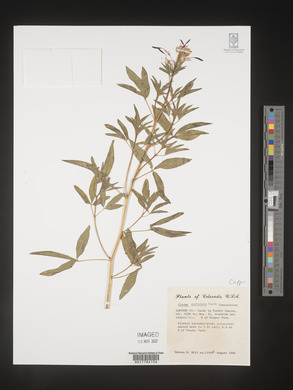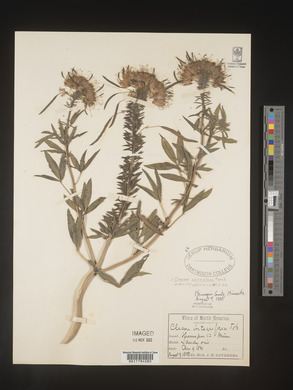Cleomella serrulata
|
|
|
|
Family: Cleomaceae
Rocky Mountain Beeplant, more...bee spiderflower, Rocky Mountain beeplant
[Atalanta serrulata (Pursh) Nutt., moreCleome serrulata Pursh, Cleome serrulata var. angusta (M.E. Jones) Tidestrom, Cleome serrulata var. serrulata Pursh, Peritoma angustum Rydb., Peritoma serrulata (Pursh) DC.] |
Annual herb 0.5 - 0.8 m tall Stem: branching near top, sometimes having few fine hairs when young, becoming hairless. Leaves: compound with three leaflets (trifoliate), 3 - 6 cm long, narrow lance-shaped, abruptly pointed, non-toothed, often slightly hairy when young. Flowers: borne in a terminal inflorescence (raceme), pink (rarely white), with four sepals and six stamens. The four petals reach 1 cm long with the base narrowing to a short claw. Fruit: an elongated two-valved capsule, long-stalked, 3 - 5 cm long, cylindrical and abruptly contracted at intervals between seeds (torulose), hairless, with interconnecting veins, opening from base to tip, releasing kidney-shaped seeds. Similar species: Cleome hassleriana is easily distinguished from Cleome serrulata because it has leaves with five to seven leaflets and a stem covered in sticky hairs. Polanisia species are distinguished by having more than six stamens, petals with a notched tip, and more or less stalkless fruit. Flowering: July to September Habitat and ecology: Introduced from farther west, this species is occasionally found in disturbed soil. Occurence in the Chicago region: non-native Etymology: Cleome is the ancient name for a mustard-like plant. Serrulata means "with small teeth." Author: The Morton Arboretum Allred and Ivey 2012, Heil et al. 2013, Springer et al. 2008, MacDougall 1973 Duration: Annual Nativity: Native Lifeform: Forb/Herb General: Annual herbs, 30 cm to 2 m tall, from a taproot; stems erect, unbranched or branched above; herbage mostly glabrous. Leaves: Alternate along the stems, the lower leaves long-petiolate and upper leaves sessile or nearly so; blades compound with 3 distinct leaflets, the leaflets lanceolate, oblanceolate, or elliptic, 2-8 cm long and 5-17 mm wide, the margins entire. Flowers: Lavender and showy, in terminal racemes 5-25 cm or more long; flowers slightly asymmetric, with the petals pushed to one side of the flower rather than evenly dispersed around the center; sepals 4, purple or green, with minutely serrulate margins; petals 4, lavender; stamens 6, with purple filaments. Fruits: Capsules linear to oblong, 2-7 cm long, slightly constricted between the seeds, and loosely pendulous on long pedicels; containing many black or gray-mottled, ovoid seeds, 3-4 mm long. Ecology: Found in open fields, roadsides, and other moist disturbed habitats, from 3,000-9,500 ft (914-2896 m); flowers May-August. Distribution: Widespread throughout western North America. Notes: This is a fairly common native roadside weed, which becomes especially abundant at higher elevations during the late summer monsoons. It often co-occurs with the sunflowers which can also appear in abundance during the same season. Look for a large (1-2 m tall) upright annuals topped with clusters of showy, pink-purple, 4-petaled flowers and long, slender, dangling seed pods. The herbage has an odd, somewhat unpleasant scent, but the scent apparently disappates with cooking, and the plant is said to have saved the Navajo from starvation many times. Host plant for the cabbage white butterfly. Look for it under Cleome serrulata in older texts, in the family Capparidaceae (caper family). Ethnobotany: The Navajo use a steeped seed tea as a blood purifier, to improve one's voice, and to treat colds. Leaves are also used as a natural deodorant. Leaves, flowers, and seed are eaten by the Hopi, Navajo, and Apache, and the Navajo make a yellow-green wool dye from the fermented plant. Etymology: Peritoma comes from the Greek peri-, all around, and tome, a slice or cut, alluding the circumcessile calyx base of some species; serrulata means saw-like, and refers to the minutely toothed sepals. Editor: AHazelton 2017 Stems 5-8 dm, branched above, pale, glabrous or nearly so; petioles not spiny; lfls 3, narrowly lanceolate, 3-6 cm, sharply acuminate or cuspidate, entire, glabrous at maturity, sometimes finely and sparsely villosulous when young; bracts crowded, lanceolate, short-petioled; pet subequally disposed, pink (white), oblong, 1 cm, the blade narrowed to the base and much exceeding the claw; fr torulose, 3-5 cm, glabrous, the stipe 1.5-2 cm, about equaling the pedicel; 2n reputedly =32, 34, 60. Prairies; Ind. to Mo. and Minn., w. to Sask., Wash., Calif., and Tex. July, Aug. Gleason, Henry A. & Cronquist, Arthur J. 1991. Manual of vascular plants of northeastern United States and adjacent Canada. lxxv + 910 pp. ©The New York Botanical Garden. All rights reserved. Used by permission. From Flora of Indiana (1940) by Charles C. Deam Indiana Coefficient of Conservatism: C = null, non-native Wetland Indicator Status: FACU |
|
|
|






























































































